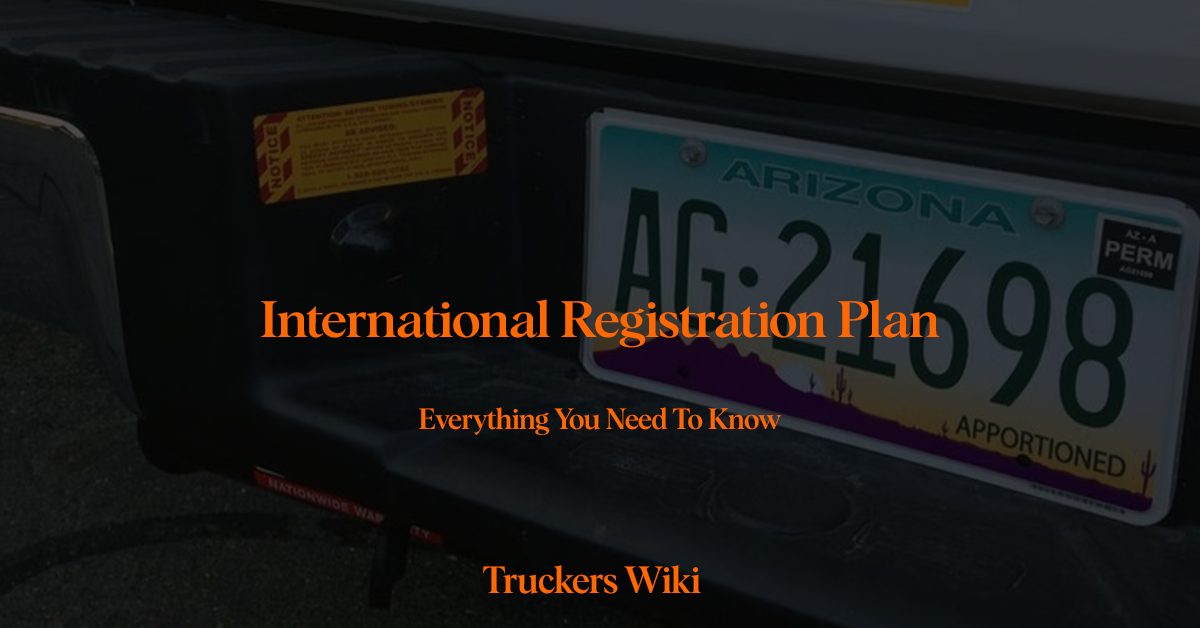
Table of Contents
What is the International Registration Plan IRP
The International Registration Plan (IRP) is a reciprocal agreement among the states of the United States, the District of Columbia, and provinces of Canada, facilitating commercial vehicle registration and operation across jurisdictions.
The IRP’s primary goal is to promote the efficient and effective taxation of commercial motor vehicles that travel interjurisdictionally.
By simplifying the registration process, the IRP allows carriers to obtain a single registration plate and cab card for each vehicle, which are recognized across all member jurisdictions.
Learn about Cab Card here.
Here are the main features and points to know about the International Registration Plan in trucking.
Cross-Jurisdictional Travel
The IRP addresses the needs of commercial motor vehicles (CMVs) that travel across multiple jurisdictions, whether within the United States or between U.S. states and Canadian provinces. This is crucial for carriers engaged in interstate commerce, ensuring they can operate seamlessly without the burden of obtaining separate registrations for each jurisdiction.
Single Registration
Under the IRP, carriers obtain a single registration called an apportioned plate. This plate serves as a comprehensive proof of registration, enabling the vehicle to legally travel in all IRP member jurisdictions. It eliminates the need for carriers to manage numerous individual registrations in different states and provinces.
Registration Process
Registering under the IRP involves several key steps:
- Application: Carriers must apply through their base jurisdiction, defined as the state or province where the carrier has an established place of business and where operational records are kept or can be made available.
- Documentation: Applicants must provide proof of an established place of business, vehicle details, and estimated distance to be traveled in each jurisdiction during the registration period.
- Fee Calculation: Fees are calculated based on the type of vehicle, its weight, and the total distance traveled in each member jurisdiction.
- Issuance of Credentials: Upon payment of the calculated fees, the base jurisdiction issues an IRP plate and a cab card for each registered vehicle. The cab card lists all jurisdictions where the vehicle is authorized to operate.
Prorated Registration Fees
IRP’s prorated registration fees are based on the principle of proportionality. Carriers pay fees based on the anticipated percentage of miles they will travel in each jurisdiction. This system ensures that registration fees accurately reflect the carrier’s actual use of roadways in different jurisdictions, providing a fair distribution of revenue among member states and provinces.
Apportionable Vehicles
Apportionable vehicles, often referred to as apportioned vehicles, are those that are used or intended to be used for the transportation of persons for hire or designed, used, or maintained primarily for the transportation of property.
These vehicles have the characteristic of being operated in two or more IRP jurisdictions and have a gross vehicle weight rating (GVWR) of 26,001 pounds or more, or have three or more axles, regardless of weight.
The key criteria for a vehicle to be considered apportionable are:
- The vehicle is used or intended for use in two or more member jurisdictions (states or provinces).
- The vehicle is used for the transportation of persons for hire or is designed, used, or maintained primarily for the transportation of property.
- The vehicle meets one of the following criteria:
- Has two axles and a gross vehicle weight or registered gross vehicle weight exceeding 26,000 pounds (11,793.401 kilograms).
- Has three or more axles, regardless of weight.
- Is used in combination, and the gross vehicle weight of the combination exceeds 26,000 pounds (11,793.401 kilograms).
Exceptions are provided for recreational vehicles, vehicles displaying restricted plates, and government-owned vehicles. Additionally, trucks or truck tractors, or combinations of vehicles with a gross vehicle weight of 26,000 pounds (11,793.401 kilograms) or less are optional for apportioned registration.
Simplified Administration
The IRP significantly simplifies the administrative process for carriers. Instead of dealing with the complexities of registering in multiple jurisdictions, carriers apply for registration and pay fees to their base jurisdiction. The base jurisdiction then manages the distribution of fees to other member jurisdictions, reducing administrative overhead and paperwork for carriers.
Apportioned Plates
Once registered through the IRP, carriers receive an apportioned license plate. This plate is recognized as valid documentation of registration in all IRP member jurisdictions. It helps law enforcement and other authorities quickly identify vehicles that are properly registered and authorized to operate in various states and provinces.
Reporting and Compliance
Carriers operating under the IRP are required to maintain accurate records of their mileage. These records serve as the basis for calculating prorated fees and ensuring compliance with registration obligations.
Carriers must also maintain trip records that accurately document their operations in each jurisdiction.
Enforcement
The IRP’s standardized apportioned plates and registration documentation simplify enforcement efforts. Law enforcement agencies across member jurisdictions recognize these documents as evidence of proper registration. This facilitates efficient enforcement of regulations and helps ensure that CMVs are in compliance with registration requirements while traveling across various regions.
Flexibility
The IRP offers carriers operational flexibility. Carriers can adjust their routes and operations without the need to obtain new registrations for each jurisdiction they enter. This flexibility is essential for carriers navigating the dynamic nature of interstate commerce.
IRP in the Trucking Industry
The IRP significantly impacts the trucking industry by facilitating cross-border operations and promoting efficiency. It allows carriers to plan routes more effectively, ensuring compliance with jurisdictional requirements while minimizing operational costs. Moreover, the IRP supports the industry’s contribution to the economy by streamlining interstate and international commerce.
Learn about Heavy Vehicle Use Tax (Highway Use Tax) here.
Learn more about Safety here.
External Links
Listen to The Article Here
Audio Article International Registration Plan IRP What is the
Last modified: February 3, 2024

